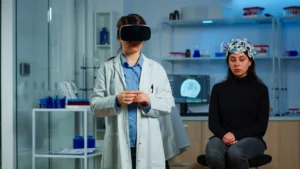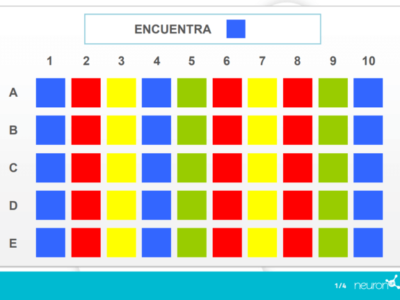On the occasion of Brain Awareness Week 2025, in this article we explore the technological applications of virtual reality (VR) in cognitive therapy, highlighting the therapeutic benefits and its impact on improving patients’ personal relationships.
Introduction
In recent years, the virtual reality (VR) has emerged as an innovative tool in the field of neuropsychology, revolutionizing the way professionals approach cognitive therapy. Its application allows the creation of immersive and controlled environments that facilitate the rehabilitation of cognitive functions affected by various neurological conditions.
Applications of virtual reality (VR) in cognitive therapy
1. Rehabilitation of cognitive functions
One of the main uses of virtual reality in cognitive therapy is the rehabilitation of executive functions, memory, attention and processing speed. VR allows designing environments that replicate real-life situations and challenge the patient to solve problems, remember information and improve their ability to concentrate.
For example, patients with acquired brain injury can benefit from virtual scenarios that simulate everyday activities, such as grocery shopping or preparing a meal, promoting the recovery of essential functional skills.
2. Treatment of neurodevelopmental disorders
In the field of neurodevelopmental disorders, virtual reality has proven to be a valuable tool in the treatment of conditions such as ADHD and ASD. Through virtual reality (VR), patients can practice emotional regulation, improve decision-making and develop social skills in controlled environments tailored to their individual needs.
3. Intervention in neurodegenerative diseases
VR also offers significant benefits in the treatment of neurodegenerative diseases such as Alzheimer’s disease and Parkinson’s disease. It has been shown that immersive environments can help slow cognitive decline by stimulating memory, place orientation and fine motor skills. Moreover, these experiences can improve patients’ motivation and quality of life.
4. Management of stress and anxiety
Virtual reality has been successfully used in exposure therapy to treat phobias, post-traumatic stress disorder (PTSD) and anxiety. Virtual environments allow patients to face their fears gradually and in a controlled way, promoting desensitization and the development of effective coping strategies.

Subscribe
to our
Newsletter
Therapeutic benefits of virtual reality in neuropsychology
1. Personalization of treatments
One of the most notable aspects of VR in cognitive therapy is the ability to tailor interventions to the specific needs of each patient. Thanks to technology, it is possible to adjust the level of difficulty, the stimuli and the therapeutic goals according to the progression of the treatment.
2. Increased motivation and therapeutic adherence
The interactive and playful nature of virtual reality increases patient engagement and commitment to therapy. This additional motivation can promote greater adherence to treatment and, depending on the case, contribute to better long-term therapeutic outcomes
3. Safe and controlled environments
The ability to recreate real situations in a safe environment allows patients to experience and practice skills without risk. This is especially relevant in the treatment of phobias, motor rehabilitation and social skills training.
4. Objective assessment of progress
Virtual reality facilitates the collection of accurate data on patient performance, allowing neuropsychologists to carry out more objective assessments and adjust interventions according to the patient’s progress.
Impact of virtual reality (VR) on personal relationships
One of the goals of neuropsychology is to improve patients’ quality of life, which includes strengthening their interpersonal relationships. Virtual reality (VR) can play a key role in this regard by:
- Facilitate the practice of social skills: Patients with difficulties in social interaction can benefit from simulations where they practice conversations, body language and emotion recognition.
- Reduce social anxiety: Gradual exposure to social situations through VR can improve confidence and comfort in real interactions.
- Improve empathy and understanding: Through immersive experiences, patients can put themselves in others’ shoes and develop greater sensitivity to others’ emotions.
Conclusions
The integration of virtual reality into cognitive therapy represents a significant advance in the field of neuropsychology. Its technological applications allow personalizing treatments, increasing patient motivation and providing safe environments for the rehabilitation of cognitive functions. In addition, its impact on improving personal relationships reinforces its value as a therapeutic tool.
As technology continues to evolve, it is essential that neuropsychology professionals explore and take advantage of the potential of virtual reality to optimize their interventions and improve their patients’ quality of life.
If you liked this blog post about the virtual reality in cognitive therapy, you will likely be interested in these NeuronUP articles:
“This article has been translated. Link to the original article in Spanish:”
Realidad virtual en terapia cognitiva: Aplicaciones y beneficios en neuropsicología







 Cognitive rehabilitation in patients with multiple sclerosis: strategies to improve quality of life
Cognitive rehabilitation in patients with multiple sclerosis: strategies to improve quality of life
Leave a Reply